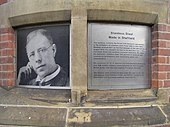Harry Brearley
Harry Brearley (born February 18, 1871 in Sheffield , England ; † August 12, 1948 in Torquay ) is considered the inventor of stainless steel in the Anglo-Saxon world , while in Germany the Krupp company applied for a patent on stainless steel a year before Brearley's breakthrough .
At the age of 12 he started as a worker in a steel mill, where he was later transferred to the chemistry laboratory as an assistant. In addition to work, he studied steel production techniques and chemical analysis methods at home and in evening school and earned a good reputation. In 1908 two steel companies merged and founded the joint research laboratory Brown Firth Laboratories , which Brearley directed.
In the years leading up to World War I , Brearley conducted research into steel production for the manufacture of firearms . The barrels of the guns eroded too quickly due to the high temperatures. On August 13, 1913, Brearley added chromium to the steel and found in later investigations that the steel was subject to less wear and tear at high temperatures due to the higher melting point. The chrome steel was also resistant to chemicals. His rustless steel was therefore also suitable for the production of cutlery.
However, the war interrupted further development. In 1915 he left the laboratory because of patent disputes and his successor was Dr. William Herbert Hatfield . In his honor, Mount Brearley in Antarctica bears his name.
Individual evidence
- ↑ Nicholas Clayton: A Butler's Guide to Table Manners. Pavilion Books, 2016, ISBN 978-1-84994-413-7 , ( Google snippet ).
| personal data | |
|---|---|
| SURNAME | Brearley, Harry |
| BRIEF DESCRIPTION | British inventor of stainless steel |
| DATE OF BIRTH | February 18, 1871 |
| PLACE OF BIRTH | Sheffield , England |
| DATE OF DEATH | August 12, 1948 |
| Place of death | Torquay |
